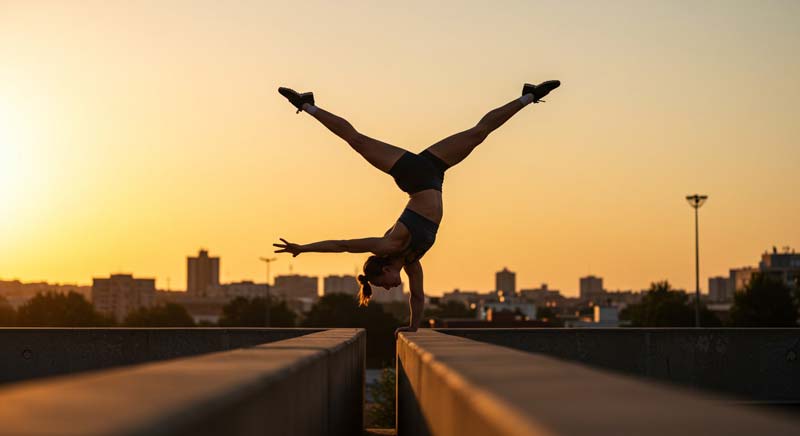Skill-related components of fitness form the building blocks of movement quality and athletic ability. These six essential elements – agility, balance, coordination, power, reaction time, and speed – work together to enhance physical performance in sports and daily life.
For those who have mastered the fundamental aspects of physical wellness, these abilities take movement capabilities to new levels. Each component serves a unique purpose, from maintaining stability to generating explosive force.
The chart below outlines these key components and their definitions. Each component serves a distinct purpose: agility helps you manoeuvre around obstacles, while coordination ensures smooth movement patterns. Balance maintains stability during tasks, and power adds force to movements.
Skill-Related Components of Fitness:
Research shows these abilities enhance both athletic performance and everyday activities. Whether playing sports or climbing stairs with shopping bags, these components work as a unified system. The interaction between components creates fluid, efficient movements that adapt to various situations.
In the sections that follow, we’ll examine each component in detail. You’ll discover how agility influences quick movements, balance affects stability, coordination shapes movement patterns, power drives athletic performance, reaction time speeds responses, and speed influences movement quality.
Agility
Agility demands precise control of body movements in response to changing situations. This quality proves essential in sports like football, where players must swiftly change direction while maintaining control.
Research shows agility significantly influences movement with a ball, particularly in football dribbling and handball performance. Players with superior agility often demonstrate better ball control and movement precision during matches.
The impact of sedentary behaviour on agility deserves attention. Studies reveal that prolonged sitting leads to decreased physical function. Consequently, regular movement breaks help maintain agility and overall movement quality.
Training incorporating ladder drills and cone exercises enhances overall movement efficiency. Moreover, integrative neuromuscular training (skill-related components of fitness) shows improved motor competence and reduced movement awkwardness.
Evidence suggests that proper nutrition is vital in supporting reactive agility performance. Furthermore, the skill-related components of fitness benefit from specific training guidelines established by sports science research.
Professional recommendations suggest neuromotor exercises targeting agility should occur 2-3 times weekly. Each session should last 20-30 minutes, at least 60 minutes weekly, for optimal results.

Balance
Balance represents our ability to maintain equilibrium, whether standing still or moving. Like a tightrope walker adjusting their position, our body constantly makes tiny adjustments to stay upright.
This capability operates under two distinct conditions: static (remaining motionless) and dynamic (reacting while moving). Think of static balance as standing on one leg, while dynamic balance helps you navigate an icy pavement.
Research demonstrates that individuals carrying extra weight typically show reduced stability. Their centre of pressure shifts forward as the body makes compensatory movements to counteract weight distribution.
The skill-related components of fitness improve significantly through targeted balance training. Exercises like mini hurdle jumping and single-leg stand to enhance both static and dynamic stability measures.
Proper nutrition enhances dynamic balance by improving muscle strength and blood flow mechanisms. Additionally, the skill-related components of fitness benefit from activities like yoga and tai chi.
Balance serves as a foundation for learning complex motor skills. From childhood development to sports performance, good balance enables successful movement patterns in daily activities.
Research examining sedentary behaviour found important links to reduced physical function. Regular movement breaks throughout the day help maintain balance capabilities and overall stability.
Coordination
Coordination measures one’s ability to integrate sensory inputs with body movements. Like a skilled pianist synchronising both hands on the keyboard, coordination enables smooth, accurate movement patterns.
Research in volleyball and handball reveals fascinating insights about coordination abilities. Players demonstrating superior coordination perform better in technical skills like ball handling and precise movements.
The skill-related components of fitness shine exceptionally bright in team sports. Elite handball players exhibit advanced coordination patterns that influence match performance and technical execution.
Global movement patterns form the foundation of coordination training. These patterns help develop fundamental movement skills that transfer across various sports and daily activities.
Prolonged sitting significantly affects coordination abilities. Studies show reduced performance in vital tasks like transitioning from sitting to standing, reaching for objects, and maintaining fluid movements.
Integrative neuromuscular training enhances motor competence while reducing awkward movements. This training approach targets specific movement patterns to improve overall coordination efficiency.
The training focused on movement mechanics shows remarkable improvements in coordination. The skill-related components of fitness benefit particularly from exercises that challenge multiple movement patterns simultaneously.
Professional athletes commonly use coordination drills to enhance their sports performance. These drills often combine hand-eye coordination, foot movements, and overall body control in increasingly complex patterns.

Power
Power represents the rate at which work can be performed, merging strength with speed. Imagine a basketball player leaping for a rebound – their explosive movement demonstrates power in action.
Athletes require explosive strength for setting, spiking, and blocking movements, showcasing how the skill-related components of fitness work in harmony.
Neural adaptations from training enhance motor unit recruitment (activation of muscle fibres). These adaptations improve intermuscular coordination and power development during explosive movements.
High-intensity circuit training significantly boosts muscular power output. Research shows aerobic and anaerobic performance improvements through carefully structured power training programmes.
The skill-related components of fitness respond rapidly to changes in activity levels. Even short periods of reduced training can lead to decreased metabolic function and power production.
Extended inactivity affects multiple body systems. Decreased bone mineral density, metabolic dysfunction, and neuromuscular complications can result from prolonged periods without power training.
Professional guidelines recommend specific approaches to power development. Training should combine speed and strength, including plyometric drills and Olympic-style lifting movements.
Regular power training helps maintain crucial aspects of physical function. From preventing bone density loss to enhancing neuromuscular connections, power training offers wide-ranging benefits.
Reaction Time
Reaction time measures the interval between stimulation and response initiation. Picture a tennis player anticipating a serve – their success depends on this lightning-fast neural process.
Athletes across various sports rely heavily on quick reaction times. Studies with elite performers show strong relationships between reaction speed and successful performance in competitive situations.
The skill-related components of fitness significantly influence response capabilities. Quick reactions require efficient neural pathways developed through consistent training and practice.
Research examining psychophysiological properties reveals fascinating insights. Elements like visual processing speed and neural transmission efficiency directly affect reaction performance.
Total response time combines both reaction speed and movement completion. The skill-related components of fitness work together to create efficient responses to environmental demands.
Genetic factors play a considerable role in baseline reaction capabilities. However, targeted training can enhance response speed within individual genetic limitations.
Professional athletes undergo specific reaction training programmes. These programmes often incorporate visual, auditory, and tactile stimuli to develop comprehensive response abilities.

Speed
Speed capabilities shape athletic performance across numerous sports disciplines. From track athletes to football players, the ability to execute rapid movements often determines competitive success.
Research demonstrates transparent relationships between sprint performance and technical skills. The skill-related components of fitness directly influence an athlete’s capacity to perform quick, precise movements.
Speed encompasses various forms, including running, swimming, and limb movement speed. Each type requires specific training approaches to develop optimal performance capabilities.
The multicomponent nature of speed training enhances muscular performance. High-intensity, intermittent exercises show particular effectiveness in developing speed capabilities.
Training adaptations promote neural plasticity (the brain’s ability to form new connections). These changes lead to improved movement patterns and enhanced skill-related components of fitness.
Sprint mechanics benefit from targeted movement training. Research shows proper technical instruction can significantly improve running efficiency and speed output.
Speed development requires careful attention to recovery periods. Optimal rest intervals between training sessions ensure proper adaptation and prevent performance plateaus.
Physical adaptations occur rapidly with consistent speed training. However, these gains can diminish quickly without regular maintenance through structured training sessions.
The multipart interaction between movement efficiency and speed forms the foundation of athletic performance. These components work seamlessly with balance, coordination, power, and reaction time to create fluid, effective motion. Regular engagement in varied physical activities helps maintain and enhance these essential movement capabilities, contributing to lifelong physical competence.
Sources
- American College of Sports Medicine. ACSM’s Guidelines for Exercise Testing and Prescription. 10th ed. Philadelphia (PA): Wolters Kluwer; 2018. 480 p.
- Arefirad T, Seif E, Sepidarkish M, et al. Effect of exercise training on nitric oxide and nitrate/nitrite (NOx) production: a systematic review and meta-analysis. Front Physiol. 2022;13:953912.
- Bailey SJ, Winyard P, Vanhatalo A, et al. Dietary nitrate supplementation reduces the O2 cost of low-intensity exercise and enhances tolerance to high-intensity exercise in humans. J Appl Physiol. 2009;107(4):1144-1155.
- Batrakoulis A, Jamurtas AZ, Tsimeas P, Poulios A, Perivoliotis K, Syrou N, et al. Hybrid-type, multicomponent interval training upregulates musculoskeletal fitness of adults with overweight and obesity in a volume-dependent manner: a 1-year dose-response randomised controlled trial. Eur J Sport Sci. 2022;1-12.
- Bojić I, Pavlović L. Correlation between coordination and situational-motor abilities of young female handball players. Res Phys Educ, Sport and Health. 2015;4(1):105-110.
- Capodaglio P, Cimolin V, Tacchini E, Parisio C, Galli M. Balance control and balance recovery in obesity. Curr Obes Rep. 2012;1:166-73.
- Garcia-Gil M, Torres-Unda J, Esain I, Dunabeitia I, Gil SM, Gil J, et al. Anthropometric parameters, age, and agility as performance predictors in elite female basketball players. J Strength Cond Res. 2018;32(6):1723-1730.
- Fort-Vanmeerhaeghe A, Romero-Rodriguez D, Lloyd RS, Kushner A, Myer GD. Integrative neuromuscular training in youth athletes. Part II: strategies to prevent injuries and improve performance. Strength Cond J. 2016;38:9–27.
- Fort-Vanmeerhaeghe A, Montalvo A, Latinjak A, Unnithan V. Physical characteristics of elite adolescent female basketball players and their relationship to match performance. J Hum Kinet. 2016;53:167-178.
- Garcia-Gil M, Torres-Unda J, Esain I, Dunabeitia I, Gil SM, Gil J, et al. Anthropometric parameters, age, and agility as performance predictors in elite female basketball players. J Strength Cond Res. 2018;32(6):1723-1730.
- Grosset JF, Piscione J, Lambertz D, Pérot C. Paired changes in electromechanical delay and musculo-tendinous stiffness after endurance or plyometric training. Eur J Appl Physiol. 2009;105:131-9.
- Guzmán-Muñoz E, Sazo-Rodriguez S, Concha-Cisternas Y, Valdés-Badilla P, Lira-Cea C, Silva-Moya G, et al. Four weeks of neuromuscular training improve static and dynamic postural control in overweight and obese children: a randomised controlled trial. J Mot Behav. 2020;52:761-9.
- Katić R, Grgantov Z, Jurko D. Motor structures in female volleyball players aged 14-17 according to technique quality and performance. Coll Antropol. 2006;30(1):103-112.
- Kleim JA, Jones TA. Principles of experience-dependent neural plasticity: implications for rehabilitation after brain damage. J Speech Lang Hear Res. 2008;51:S225-39.
- Knight JA. Physical inactivity: associated diseases and disorders. Ann Clin Lab Sci. 2012;42(3):320-37.
- Kutlu M, Yapici H, Yilmaz A. Reliability and validity of a new test of agility and skill for female amateur soccer players. J Hum Kinet. 2017;56:219–227.
- Lee I-M, Shiroma EJ, Lobelo F, Puska P, Blair SN, Katzmarzyk PT. Effect of physical inactivity on major non-communicable diseases worldwide: an analysis of burden of disease and life expectancy. Lancet. 2012;380(9838):219-29.
- Lloyd RS, Faigenbaum AD, Stone MH, Oliver JL, Jeffreys I, Moody JA, et al. Position statement on youth resistance training: the 2014 International Consensus. British Journal of Sports Medicine, 48, 498-505.
- Melo RS, Tavares-Netto AR, Delgado A, Wiesiolek CC, Ferraz KM, Belian RB. Does the practice of sports or recreational activities improve the balance and gait of children and adolescents with sensorineural hearing loss? A systematic review. Gait Posture. 2020; 77: 144-55.
- Mickle KJ, Munro BJ, Steele JR. Gender and age affect balance performance in primary school-aged children. J Sci Med Sport. 2011; 14(3): 243-8.
- Mujika I, Santisteban J, Impellizzeri FM, Castagna C. Fitness determinants of success in men’s and women’s football. J Sports Sci. 2009;27(2):107-114.
- Myer GD, Faigenbaum AD, Ford KR, Best TM, Bergeron MF, Hewett TE. When to initiate integrative neuromuscular training to reduce sports-related injuries and enhance health in youth? Current Sports Medicine Reports, 10, 155-66.
- Ouerghi N, Fradj MKB, Bezrati I, Khammassi M, Feki M, Kaabachi N, et al. Effects of high-intensity interval training on body composition, aerobic and anaerobic performance and plasma lipids in overweight/obese and normal-weight young men. Biol Sport. 2017;34:385-92.
- Paillard T. Plasticity of the postural function to sport and/or motor experience. Neurosci Biobehav Rev. 2017; 72: 129-52.
- Rogers RR, Davis AM, Rice AE, et al. Effects of acute beetroot juice ingestion on reactive agility performance. Oxygen. 2022;2(4):570–577.
- Santos DA, Silva AM, Baptista F, et al. Sedentary behavior and physical activity are independently related to functional fitness in older adults. Exp Gerontol. 2012;47(12):908-12.
- Sardinha LB, Santos DA, Silva AM, Baptista F, Owen N. Breaking-up sedentary time is associated with physical function in older adults. J Gerontol A Biol Sci Med Sci. 2015;70(1):119–24.
- Sheppard JM, Young WB. Agility literature review: classifications, training and testing. J Sports Sci. 2006;24(9):919–932.
- Stamm R, Stamm M, Thomson K. Role of adolescent female volleyball players’ psychophysiological properties and body build in performance of different elements of the game. Percept Mot Skills. 2005;101(1):108-120.
- Stamm R, Veldre G, Stamm M, Thomson K, Kaarma H, Loko J, et al. Dependence of young female volleyballers’ performance on their body build, physical abilities, and psychophysiological properties. J Sports Med Phys Fitness. 2003;43(3):291-299.
- Surgeon General’s Report on Physical Activity and Health, USDHHS, 1996 as adapted from Corbin and Lindsey, 1994. Journal of Sports Sciences, 24(9), 919-932.
- Tompsett C, Burkett B, McKean MR. Comparing performances of fundamental movement skills and basic human movements: a pilot study. Journal of Fitness Research, 4, 13-25.
- Valadés D, Palao JM, Aúnsolo Á, Ureña A. Correlation between ball speed of the spike and the strength condition of a professional women’s volleyball team during the season. Kinesiology. 2016;48(1):87-94.
- Vukovich MD, Arciero PJ, Kohrt WM, Racette SB, Hansen PA, Holloszy JO. Changes in insulin action and GLUT-4 with 6 days of inactivity in endurance runners. J Appl Physiol (1985). 1996;80(1):240-4.



